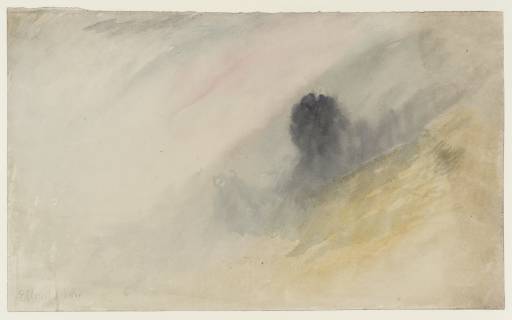Joseph Mallord William Turner ?Llanthony Abbey c.1834
Joseph Mallord William Turner,
?Llanthony Abbey
c.1834
Joseph Mallord William Turner 1775–1851
?Llanthony Abbey c.1834
D25136
Turner Bequest CCLXIII 14
Turner Bequest CCLXIII 14
Watercolour on white wove paper, 305 x 497 mm
Inscribed by Turner in pencil ‘[?Lee...]’ top left and ‘Elliotts paper’ bottom left
Inscribed in red ink ‘14’ bottom right
Blind-stamped with Turner Bequest monogram towards bottom centre
Stamped in black ‘CCLXIII – 14’ bottom right
Inscribed by Turner in pencil ‘[?Lee...]’ top left and ‘Elliotts paper’ bottom left
Inscribed in red ink ‘14’ bottom right
Blind-stamped with Turner Bequest monogram towards bottom centre
Stamped in black ‘CCLXIII – 14’ bottom right
Accepted by the nation as part of the Turner Bequest 1856
Exhibition history
1990
Turner’s Papers: A Study of the Manufacture, Selection and Use of his Drawing Papers 1787–1820, Tate Gallery, London, October 1990–January 1991 (55, reproduced, as ‘Landscape with Trees; stormy effect’).
2007
Hockney on Turner Watercolours, Tate Britain, London, June 2007–February 2008 (not in catalogue, as ‘Landscape with Trees; Stormy Effect’).
References
1909
A.J. Finberg, A Complete Inventory of the Drawings of the Turner Bequest, London 1909, vol.II, p.815, CCLXIII 14, as ‘Landscape, with trees; stormy effect’. c.1820–30.
1966
Jack Lindsay, J.M.W. Turner: His Life and Work: A Critical Biography, London 1966, colour pl. IV, as a ‘colour structure’.
1975
Gerald Wilkinson, Turner’s Colour Sketches 1820–34, London 1975, p.102, reproduced in colour.
1979
Andrew Wilton, J.M.W. Turner: His Life and Work, Fribourg 1979, pp.187, 191 note 30.
1990
Peter Bower, Turner’s Papers: A Study of the Manufacture, Selection and Use of his Drawing Papers 1787–1820, exhibition catalogue, Tate Gallery, London 1990, pp.124–5 no.55, reproduced, as ‘Landscape with Trees; stormy effect’.
1997
Eric Shanes, Turner’s Watercolour Explorations 1810–1842, exhibition catalogue, Tate Gallery, London 1997, pp.30–1, 95, 100, 104 (p.95, Appendix I under ‘England and Wales Series’, as ‘?Study for Llanthony Abbey, Monmouthshire’. c.1834, p.100 under ‘Paper Test-Sheets?’, p.104 Appendix II, as ‘Study: ?Llanthony Abbey/paper test-sheet’).
This colour study may relate to the finished watercolour Llanthony Abbey, Monmouthshire of about 1834 (Indianapolis Museum of Art),1 engraved in 1836 for the Picturesque Views in England and Wales (Tate impression: T06118). The ruined priory itself, towards the right in the middle distance in the latter, is not apparent here, and the identification was suggested rather tentatively by Andrew Wilton in terms of the colour study’s ‘strong, slanting shafts of colour’,2 corresponding to the stormy light effects in the watercolour, and mentioned by him subsequently in conversation with Peter Bower.3
Finberg compared this sheet with ‘No.35’6 (i.e. Tate D25157; Turner Bequest CCLXIII 35), which he called ‘The wooded river banks’; it too has an effect of diagonal sunbeams from the top right, although it is not close compositionally in other respects, and Shanes has suggested it shows Lake Tiny, near Farnley Hall, Yorkshire.7
See also the introductions to the present subsection of identified subjects and the overall England and Wales ‘colour beginnings’ grouping to which this work has been assigned.
Technical notes:
Bower has identified this as one half of a sheet of machine-made printing paper of ‘Sheet and a half Post Folio’ format (23 ½ x 19 ½ inches, or 596 x 495 mm), made by Richard Elliott at Chesham Bois Mill, Buckinghamshire, hence Turner’s inscription ‘Elliotts paper’. The torn edge at the top matches the bottom edge of a colour study of The Crimson Clouds (Tate D25292; Turner Bequest CCLXIII 170), which bears a similar inscription. Bower suggests that the sheet was made in about 1810, a very early date for machine-made paper, and ‘so far’ the only such early sheet identified in the Turner Bequest; Turner’s use of it may have been experimental, and it probably proved not to meet his need for the ‘subtle character and qualities’ he found in hand-made papers.1 Eric Shanes proposes that the present half may have been used for testing ‘deep tones’, and the Crimson Clouds half for ‘rich colours’.2
Bower has identified this as one half of a sheet of machine-made printing paper of ‘Sheet and a half Post Folio’ format (23 ½ x 19 ½ inches, or 596 x 495 mm), made by Richard Elliott at Chesham Bois Mill, Buckinghamshire, hence Turner’s inscription ‘Elliotts paper’. The torn edge at the top matches the bottom edge of a colour study of The Crimson Clouds (Tate D25292; Turner Bequest CCLXIII 170), which bears a similar inscription. Bower suggests that the sheet was made in about 1810, a very early date for machine-made paper, and ‘so far’ the only such early sheet identified in the Turner Bequest; Turner’s use of it may have been experimental, and it probably proved not to meet his need for the ‘subtle character and qualities’ he found in hand-made papers.1 Eric Shanes proposes that the present half may have been used for testing ‘deep tones’, and the Crimson Clouds half for ‘rich colours’.2
Verso:
Blank
Blank
Matthew Imms
March 2013
How to cite
Matthew Imms, ‘?Llanthony Abbey c.1834 by Joseph Mallord William Turner’, catalogue entry, March 2013, in David Blayney Brown (ed.), J.M.W. Turner: Sketchbooks, Drawings and Watercolours, Tate Research Publication, December 2013, https://www

